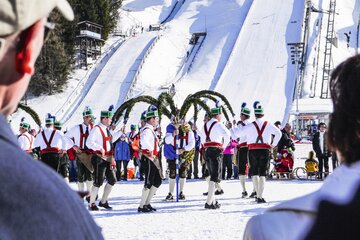Living traditions: the carnival in Garmisch-Partenkirchen
History is still alive here: Carnival in Garmisch-Partenkirchen is also full of traditions. This year, the colorful hustle and bustle is cancelled, but preparations for the Werdenfels carnival usually begin early in the year.
Carnival is a very special time in the Werdenfelser Land: It is full of traditions and customs. So it's no wonder that preparations for the colorful hustle and bustle often begin far in advance.
Colorful round dance at the Schäfflertanz
The traditional carnival in Garmisch-Partenkirchen includes, for example, the Schäffler dance. To a catchy tune, men in traditional costume show what they can do: with bows wrapped around boxwood or yew branches, they dance traditional figures. In addition, there will be music, flag bearers and tricks. According to legend, the Schäffler dance was performed for the first time as early as 1517. The plague had brought social life to a standstill at that time. Matthias Wackerle of GaPa Tourism reports, "The citizens sat in their houses and didn't dare go outside for fear of catching it." According to tradition, the Schäffler were the first to move back into the streets and lured the other people out of their houses with joyful dancing and music. The plague did not return after that, and out of gratitude the Schäffler made a vow to perform their dance again and again. To this day, this tradition is part of Fasnacht in Garmisch-Partenkirchen, even if it cannot be celebrated this year.
A tradition goes on the road
Then, around 1900, the craft of the Schäffler died out and a charitable association, the Spar- und Stopselclub Partenkirchen, took over the traditional dance. "This was originally an association of poor people," explains Wackerle, who is himself active in the club. "They had collected money for maids and farmhands so that they could afford medical care. Even today, we club members are socially engaged, taking care of monuments, fountains, wayside shrines and supporting many a church renovation."
More than 60 performers comprise the dance, they are called, for example, Triebler, Schäfflermeister and journeymen. "The figures to be danced always remain the same, we pass on the tradition from generation to generation," says Wackerle. In addition to the dancers, a music band, drum cortege, Hanswurstel and others are also part of the party - around 120 men in total. The performances for the carnival in Garmisch-Partenkirchen are always prepared from May of the previous year: then the costumes are checked and, if necessary, darned or repaired. "Between October and Christmas we then rehearse," reveals Wackerle. "And we're all looking forward to it starting up again to the familiar tune of 'Aber heit ist koit'."
Small larvae for maschkera children's group
Children are also allowed to join in the carnival in Garmisch-Partenkirchen: The Maschkera children's group starts preparing for the Werdenfels carnival right after Christmas Day. Maschkera is the name given to the traditional disguise for this custom. The merry carnival, unrecognized behind wooden masks, the so-called larvae, follows an ancient custom. "This only exists in our area and is something very special," says Daniel Neuner in his cozy parlor in Burgrain, where numerous wooden larvae hang. In his children's group, boys and girls between the ages of five and twelve learn "how to 'Maschkera Gehen' just like the adults," says the Garmisch carver and musical cabaret artist proudly. "In the beginning, it wasn't that easy," he recalls. "It was my goal to continue the tradition - and that's exactly what we manage to do," Neuner is pleased to say. So today, small and large can live the traditions of the Werdenfels carnival.










